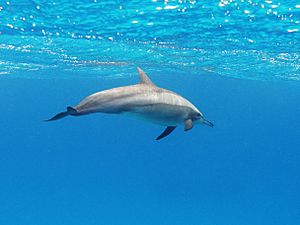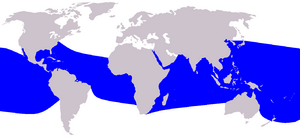Spinner dolphin facts for kids
Quick facts for kids Spinner dolphin |
|
|---|---|
 |
|
| A spinner dolphin in the Red Sea | |
 |
|
| Size compared to an average human | |
| Conservation status | |
| Scientific classification | |
| Genus: |
Stenella
|
| Species: |
longirostris
|
| Subspecies | |
|
|
 |
|
| Spinner Dolphin range | |
The spinner dolphin (Stenella longirostris) is a small dolphin that lives in warm, tropical waters all over the world. It's super famous for its amazing acrobatic moves, especially how it spins in the air while jumping! It belongs to the oceanic dolphin family, which are a type of toothed whale.
Contents
About Spinner Dolphins
The spinner dolphin is sometimes called the long-snouted dolphin, especially in older books. This helps tell it apart from the Clymene dolphin, which looks similar but has a shorter snout. A scientist named John Gray first described this species in 1828.
There are four main types, or subspecies, of spinner dolphins:
- Eastern spinner dolphin (S. l. orientalis): Found in the warm eastern Pacific Ocean.
- Central American or Costa Rican spinner dolphin (S. l. centroamericana): Also lives in the eastern Pacific.
- Gray's or Hawaiian spinner dolphin (S. l. longirostris): Found around Hawaii in the central Pacific. This type includes many similar dolphins from all over the world.
- Dwarf spinner dolphin (S. l. roseiventris): First discovered near the Gulf of Thailand.
Even with these subspecies, spinner dolphins show a lot of variety in how they look. For example, some have a white belly and live in the eastern Pacific. The name longirostris comes from Latin, meaning "long-beaked," which describes their snout.
What Spinner Dolphins Look Like
Spinner dolphins are small cetaceans, which means they are marine mammals like whales and porpoises. They have a slender body. Adult spinner dolphins are usually about 129 to 235 centimeters (about 4 to 7.7 feet) long. They weigh between 23 and 79 kilograms (about 50 to 174 pounds).
This dolphin has a long snout, called a rostrum. Its dorsal fin (the fin on its back) is usually shaped like a triangle. Spinner dolphins typically have three colors: dark gray on top, light gray on their sides, and pale gray or white underneath. They also have a dark stripe that goes from their eye to their flipper, with a thin, light line above it.
However, spinner dolphins can look very different depending on where they live. For example, those in the eastern Pacific Ocean have smaller heads and shorter snouts. There's even a dwarf type of spinner dolphin found near Southeast Asia. Some males in certain groups might have unusual upright fins that point forward. In the eastern Pacific, some spinner dolphins can even have strange dorsal fins that point backward, and males might have bumps and upturned tail flukes.
Where Spinner Dolphins Live and What They Eat
Spinner dolphins live in almost all tropical and subtropical waters around the world, usually between 40 degrees north and 40 degrees south of the equator. They mostly stay near coasts, islands, or underwater banks. But in the eastern tropical Pacific, some spinner dolphins live far out in the open ocean. They might even use different places to live depending on the time of year.
Spinner dolphins mainly eat small fish that live in the middle depths of the ocean, along with squids and small shrimp. They can dive 200 to 300 meters (about 650 to 980 feet) deep to find their food. Hawaiian spinner dolphins hunt at night. They work together to herd their prey into tight groups, swimming in a circle around them. Then, a pair of dolphins might swim through the circle to catch their meal.
Dwarf spinner dolphins might eat mostly fish that live on the seafloor in reefs and shallow waters.
Who Hunts Spinner Dolphins?
Sharks are known to hunt spinner dolphins. Other animals that might prey on them include killer whales, false killer whales, pygmy killer whales, and short-finned pilot whales. Spinner dolphins can also get parasites. These can be external, like barnacles and remoras that attach to their skin, or internal, like different types of worms.
Spinner Dolphin Behavior and Life Cycle

In some areas, like Hawaii and northern Brazil, spinner dolphins spend their daytime resting in shallow bays close to deep water. When evening comes, they travel offshore to hunt for food. They usually travel along the coast during their hunting trips. The specific dolphins resting in a bay can change daily. While some dolphins don't always go to a bay to rest, those in Hawaii often return to the same resting spots.
Spinner dolphins live in open and flexible social groups. Hawaiian spinner dolphins live in family groups, but they also spend time with other dolphins outside their immediate families. Mothers and their calves (baby dolphins) form very strong bonds. Spinner dolphins might change their partners every few weeks. Sometimes, a dozen adult males will form a group or "coalition."
Spinner dolphins communicate using different sounds. They make whistles, which might help them keep their group organized. They also use burst-pulse signals and echolocation clicks, which are like sonar, to find things in the water.
Reproduction and Growth
Female spinner dolphins are pregnant for about 10 months. Mothers then nurse their young for one to two years. Females can start having babies when they are four to seven years old, and they usually have a new calf every three years. Males become ready to mate when they are seven to 10 years old. Breeding happens at certain times of the year, more so in some regions than others.
Amazing Spinning Behavior
Spinner dolphins are famous for their incredible acrobatics and jumps out of the water. When a spinner dolphin spins, it leaps out of the water headfirst and twists its body as it rises into the air. Once it reaches its highest point, it comes back down, landing on its side. A dolphin can do anywhere from two to 5.5 spins in a single jump! How fast the dolphin is swimming and spinning underwater affects how many spins it can do in the air. These spins might have several purposes, like communicating or shaking off parasites.
Dolphins also do other cool moves, like "nose-outs" (just their nose comes out), tail slaps, flips, head slaps, "salmon leaps" (jumping high and arching their back), and side and back slaps.
Protecting Spinner Dolphins
Sadly, tens of thousands of spinner dolphins, especially the eastern and white-bellied types, were killed in the 30 years after purse seine fishing for tuna started in the 1950s. This fishing method likely caused the death of about half of all eastern spinner dolphins. They have also been affected by pollution from chemicals like DDT and PCBs.
To help protect them, spinner dolphins are managed by the countries where they live and by international groups like the IATTC (Inter-American Tropical Tuna Commission). The IATTC has set limits on how many dolphins can be accidentally caught by purse seine fishing each year. They also have rules for safely releasing dolphins that get caught.
Some groups of spinner dolphins, like those in the eastern tropical Pacific and Southeast Asia, are listed on Appendix II of the Convention on the Conservation of Migratory Species of Wild Animals (CMS). This means they need international help to improve their conservation status.
Spinner dolphins are also protected by agreements like the Memorandum of Understanding for the Conservation of Cetaceans and Their Habitats in the Pacific Islands Region (Pacific Cetaceans MoU) and the Memorandum of Understanding Concerning the Conservation of the Manatee and Small Cetaceans of Western Africa and Macaronesia (Western African Aquatic Mammals MoU).
In Hawaii, many boats take people to see spinner dolphins in their resting bays every day. People often want to snorkel and interact with the dolphins. However, these activities are becoming a concern because they might disturb the dolphins. Efforts are being made to teach people how to minimize their impact on the dolphins and to create rules for these activities to keep the dolphins safe.
Images for kids
-
A pod of spinner dolphins in Kauai, Hawaii
-
Spinner dolphin at Lanai Hawaii
-
Spinner dolphin at Midway Atoll
See also
 In Spanish: Delfín acróbata para niños
In Spanish: Delfín acróbata para niños











